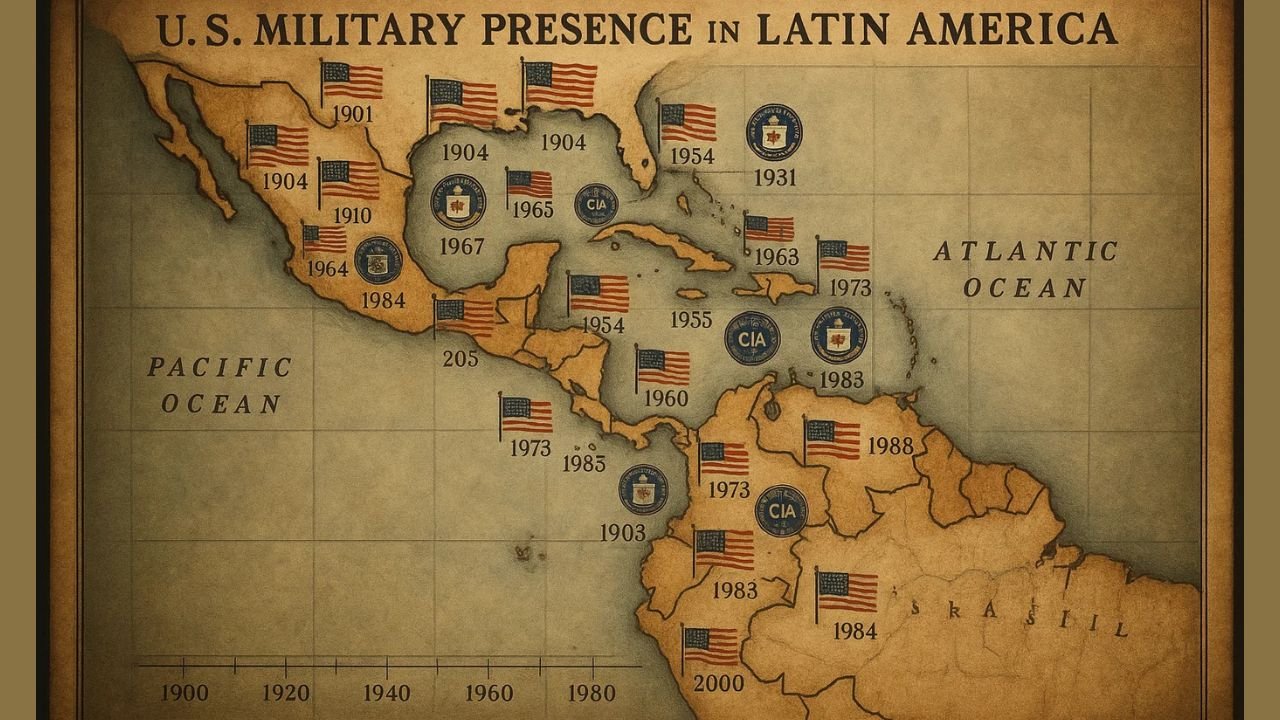Introduction
The history of American interventions in Latin America is a complex web of military actions, covert operations, economic influence, and political manipulation. Since the early 19th century, the United States has intervened in Latin American affairs, often under the banner of protecting democracy, promoting economic stability, or preventing the spread of communism. However, many of these actions have sparked long term instability, resentment, and mistrust across the region.
In this article, we’ll explore key interventions by the U.S. in Latin America, analyze the motivations behind them, and examine their lasting impact on both domestic and international politics.
Why the U.S. Intervened in Latin America
1. Economic Interests
The U.S. has long seen Latin America as a source of cheap labor, raw materials (especially bananas, oil, and sugar), and markets for American goods. Protecting American business interests often justified intervention.
2. Political Ideology
During the Cold War, fear of communist expansion led the U.S. to support anti-leftist governments and insurgent groups.
3. Strategic Geography
With Latin America in close proximity, the U.S. saw it as its “backyard.” The Monroe Doctrine and Roosevelt Corollary essentially claimed hemispheric control, discouraging European influence.
Major American Interventions in Latin America (Table)
Here’s a table summarizing key U.S. interventions across the region:
| Country | Year(s) | Type of Intervention | Description |
|---|---|---|---|
| Mexico | 1846–1848 | Military Invasion | Mexican-American War; U.S. seized California, Texas, and more. |
| Nicaragua | 1909–1933 | Military + Puppet Regime | Marines occupied; supported dictatorships to protect U.S. companies. |
| Cuba | 1898, 1961 | War + Failed Invasion | Spanish-American War; later Bay of Pigs invasion against Castro. |
| Guatemala | 1954 | CIA-backed Coup | Overthrew elected President Árbenz; installed pro-U.S. dictatorship. |
| Chile | 1973 | CIA-assisted Military Coup | Helped overthrow Allende; installed Pinochet. |
| Panama | 1989 | Military Invasion | Operation Just Cause to remove Manuel Noriega. |
| Grenada | 1983 | Military Invasion | Overthrew Marxist government after a coup; justified as protecting students. |
| El Salvador | 1980s | Military + Financial Support | Funded military against leftist rebels; heavy civilian casualties. |
| Colombia | 2000s–Present | Military & Drug Policy Aid | Plan Colombia: anti-drug and anti-insurgent aid with U.S. troops. |
| Venezuela | 2002–Present | Political + Economic Pressure | Supported failed coup, sanctions against Maduro government. |
Case Studies of U.S. Interventions
Guatemala (1954 – CIA Operation PBSUCCESS)
In 1954, the U.S. Central Intelligence Agency (CIA) orchestrated a coup to overthrow Jacobo Árbenz, a democratically elected president who enacted land reforms that affected the United Fruit Company, an American corporation. The U.S. falsely labeled Árbenz a communist threat. His overthrow led to a decades-long civil war that killed over 200,000 people.
Chile (1973 – U.S. and Pinochet)
Salvador Allende, a democratically elected socialist leader, took office in Chile in 1970. Viewing his Marxist policies as a Cold War threat, the United States, through CIA intervention and economic destabilization, backed a military coup in 1973. This U.S. supported Chilean coup led to the rise of General Augusto Pinochet, whose military dictatorship ruled Chile for 17 years marked by widespread human rights abuses, political repression, and the torture and execution of thousands of dissidents.
Panama (1989 – Operation Just Cause)
In 1989, the United States launched a military invasion of Panama to remove General Manuel Noriega, a former CIA informant who had become deeply involved in drug trafficking and defied U.S. authority. Known as Operation Just Cause, the intervention led to significant destruction and the deaths of hundreds of Panamanian civilians. While the official justification centered on combating drug smuggling and restoring democracy, many analysts argue the true motive was to protect U.S. strategic interests—particularly control over the Panama Canal and maintaining geopolitical influence in the region.
Cuba (Bay of Pigs Invasion, 1961)
Cuba’s alignment with the Soviet Union and the rise of Fidel Castro alarmed the U.S. The CIA trained Cuban exiles for an invasion at the Bay of Pigs, which failed disastrously. It embarrassed the U.S. and ultimately bolstered Castro’s hold on power, setting the stage for the Cuban Missile Crisis the following year..
Long-Term Impact on Latin America
Political Instability
Many U.S. backed regimes suppressed dissent through torture, disappearances, and martial law. This fueled cycles of rebellion and state violence that still affect countries like El Salvador, Nicaragua, and Colombia.
Anti-American Sentiment
While some governments remained loyal to the U.S., many citizens grew hostile. In places like Venezuela, U.S. policies are blamed for economic sanctions and political chaos.
Migration Crisis
Decades of war and poverty often exacerbated by U.S. interventions have contributed to the mass migration from Central America to the U.S. border.
U.S. Justifications vs. Latin American Realities
| U.S. Justification | Latin American Outcome |
|---|---|
| Stopping Communism | Led to military dictatorships |
| Promoting Democracy | Installed authoritarian regimes |
| Protecting U.S. Business Interests | Displaced workers and landowners |
| Combating Drug Trafficking | Militarization and civilian casualties |
Has U.S. Policy Changed in the 21st Century?
Since the end of the Cold War, overt U.S. military interventions have declined, but economic sanctions, political pressure, covert operations, and cyber influence continue.
The U.S. has shifted toward:
- Democracy Promotion through NGOs and media.
- Trade pressure and sanctions (e.g., Venezuela, Nicaragua).
- Drug war partnerships (e.g., Mexico, Colombia).
However, critics argue this is just a rebranding of imperialist behavior under modern terms.
Conclusion
The legacy of American interventions in Latin America is still unfolding. While U.S. foreign policy has often claimed moral high ground, the historical record reveals a pattern of intervention driven by economic interests, ideological battles, and regional dominance. For many Latin Americans, the consequences have been instability, authoritarianism, and violence.
To move forward, both the U.S. and Latin American nations must re-examine the past, promote sovereignty and transparency, and support genuine partnerships that empower rather than manipulate the region.
